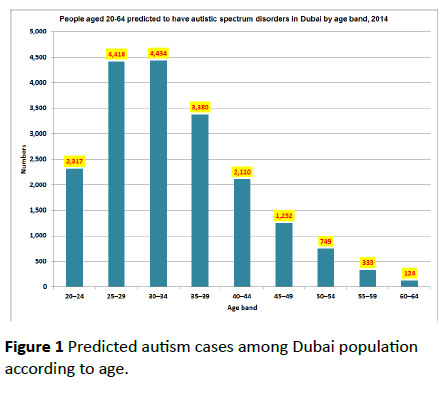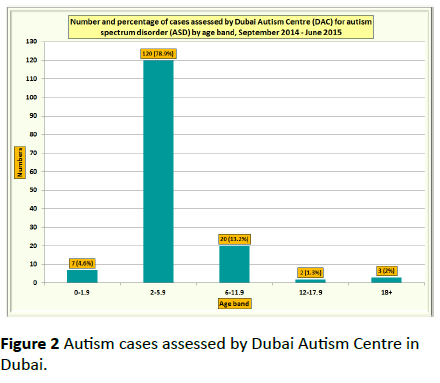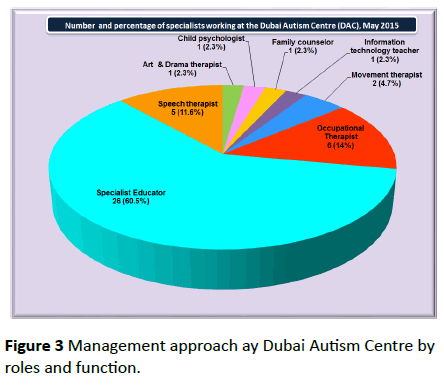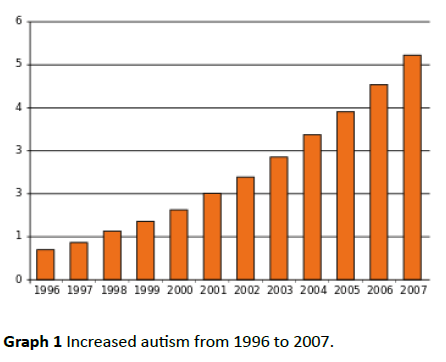Kadim Al-Abbady1,3, Hamid Yahya Hessian2* and Mohamed Wasif Alaam3
1Public Health and Safety Department, Dubai Health Authority, UAE
2Primary Health Care, Dubai Health authority, UAE
*Corresponding Author:
Hamid Hessian
Primary Health Care, Dubai Health authority, UAE
Tel: 00 971 502608873
E-mail: hyhussain@dha.gov.ae
Received date: August 01, 2017; Accepted date: August 14, 2017; Published date: August 22, 2017
Citation: Hessian HY, Abbady KA, Alaam MW (2017) Prevalence, Trend, Determinants and Prediction of Autism Spectrum Disorders Among Dubai Population, Diagnostic Approach and Management Contexts. Ped Health Res Vol.2 No.2:2. doi: 10.21762574-2817.100016
Background: Autism spectrum disorder (ASD) is becoming a major threat, large public health challenge and most common persistent developing disorder to a public health in Dubai. Most of the families are facing lifelong challenge because of the different nature of disorders like neurodevelopment disorder, which often results in an array of motor impairments. These motor impairments are the main cause of decrease performance of activities of routine life as well as in societal tasks which require specific motor abilities and skills.
Aim: To study the prevalence’s, determinants and prediction of Autism among Dubai population. To study some associated factors.
Methodology: Retrospective records review approach has been applied; qualitative methodology has been focus on the groups with mental health experts working at: Dubai Autism Centre (DAC), Al-Jalila hospital (AJH), Latifa hospital, Private Sector Healthcare (PSH), Dubai Rehabilitation Centre for Disabilities. Quantitative methodology is based on the, Prevalence, incidence. Prevalence, incidence is associated on international research (a systematic research review) as estimated as well, along with expert interviews have been applied as well.
Results: The study showed that 84.9% of the cases were males and 51.9% of the autism cases were females, 30.9% were UAE nationals and 69.1% were expatriate, about 72.4% were diagnosed as Autism spectrum disorders, 9.2% as ASD features and 9.2% were diagnosed as other disorders. Dubai Autism Centre estimates that autism is affected 1 in 146 births (0.68%). By applying these estimates to the total number of births in Dubai for 2014, it was predicted that approximately 199 children of which 58 (29.1%) were nationals and 141 (70.9%) were non– nationals suffering from autism at the same stage. Some of the families of about 16.4% of children searching help for ASD assessment between the age group 6–18+. Most of the families are not going to consult GPs for early diagnosis because of the number of reasons including cultural reasons. So, it became critical to understand late– stage diagnosis as ASD can be diagnosed much earlier and how many of these later presenters are diagnosed with ASD. The study reflected future prediction of the cases based on international standards prevalence and the population density as reflected by the figure which reflected the highest prevalence at the age intervals of 25-29 years, 30-34 years and 35-39 years respectively.
Conclusion: Autism is still on-going challenging public health issue in Dubai, in terms of rising up prevalence, incidences, trends, cases sorting out and management context of autism is one of actual national health care system gaps. There is emergence need of the nurses who are qualified and have the experience to identify children with ASD which is required to implement in regular checkup of school health. Early diagnosis of Autism awareness is increased by giving training to GP’s. There is an urgent need of interdisciplinary innovative autism centre for adult when the children leave the safe environment of the school at 18 years. These needs are followed by further studies to cover take care of needed people with an Autism Spectrum Disorder (ASD).
Keywords
Autism spectrum; Dubai population; Prevalence; Prediction
Introduction
Autism poses a particularly large public health challenge and an inspiring lifelong challenge for many families because the different nature of disease diagnosis. It is a spectrum of neurodevelopment disorder, which often results in an array of motor impairments. These motor impairments often lead to reduced performance in activities of daily living as well as in societal tasks which require specific motor abilities and skills. The estimated prevalence of autism spectrum disorders for worldwide is found to be median of 62 cases per 10,000 people. But there is no data or any kind of evidence from the low- and middle-income countries [1]. There is estimated average data of ASD for male-to-female ratio is 4.3:1 [2].
Autism have been increasing in children dramatically since the 1980s which are to be known so somehow need to change the in diagnostic practice because, it is associated to unclear autism cases whether prevalence has increased or not environmental risk factors which is unidentified, cannot be ruled out yet [3]. There are several risk factors of autism is associated to prenatal development. The factors are advanced paternal age and mother during pregnancy is suffered from diabetes [4]. ASD has been associated to several genetic disorders and with epilepsy [5,6].
British have been reported a prevalence of 3.89 per 1,000 for autism and 11.61 per 1,000 for ASD before nine- and tenyear- old i.e., in 2006. It was higher figures which could be associated to increase diagnostic criteria [7]. Autism is identified higher prevalence associated to the studies based on more information; this is based on direct observation as compared to examination of medical records. So, this recommends that published figures may underestimate ASD's true prevalence [8]. While, study of Autism in children at Cambridgeshire in 2009, England used different methods to measure prevalence, and estimated that 40% of ASD cases were undiagnosed, but still there was estimated of true prevalence being 11.3 and 15.7 per 1,000 with two least biased [9].
The estimated prevalence of 8-year-old children was found to be 9.0 per 1,000 (approximate range 8.6–9.3). This data of ASD presented by USA in 2009 is based on the study of 2006 year [10]. National Health Service also estimated the prevalence of ASD in adults were approximately 1% of the population, reported in 2009, and based on Adult Psychiatric Morbidity survey in 2007. There was found to be higher prevalence in males which was associated to no significant variation between age groups [11]. All this result of prevalence of ASD estimated that ASD among adults is similar to that in children and rates of autism are not increasing [12-14].
Objectives
To study the prevalence, determinants and prediction of Autism among Dubai population.
To study some associated factors.
Materials and Methods
Retrospective records review approach has been applied, qualitative methodology (focus groups with mental health experts working at: Al-Jalila hospital (AJH), Dubai Autism Centre (DAC), Dubai Rehabilitation Centre for Disabilities, Latifa hospital, Private Sector Healthcare (PSH).) Quantitative methodology through, Prevalence, incidence estimates based on international research (a systematic research review) along with expert interviews has been applied as well (Figures 1-3).

Figure 1: Predicted autism cases among Dubai population according to age.

Figure 2: Autism cases assessed by Dubai Autism Centre in Dubai.

Figure 3: Management approach ay Dubai Autism Centre by roles and function.
Results
The study revealed that prevalence of Autism is steadily rising along the last 4 years as per cases registry at Dubai Autism Centre for both national and expatriate population, the study showed that about two third of autism cases in Dubai is among expatriate population and on third among UAE national population as reflected by Table 1.
| Year |
Nationals |
Non–Nationals |
Total |
| 2011 |
60 |
119 |
179 |
| 2012 |
61 |
130 |
191 |
| 2013 |
60 |
138 |
198 |
| 2014 |
58 |
141 |
199 |
Table 1: Prevalence of autism cases among Dubai population by their nationality and years.
The study reflected future prediction of the cases based on international standards prevalence and the population density as reflected by Figure 1 which reflected the highest prevalence at the age intervals of 25-29 years, 30-34 years and 35-39 years respectively as shown by Figure 1. The prediction based upon the increase in the number of prevalence again the age. So, this showed that, higher prevalence in lower age people. Which reflect, the lower age is highly susceptible to the Autism. As per data the following bar described people aged 20 to 64 predicted to have Autistic Spectrum Disorders in Dubai by the age band in 2014.
The study showed that 84.9% of the cases were males and 15.1 % of the autism cases were females, 30.9% were UAE nationals and 69.1% were expatriate i.e. Non- UAE national, about 72.4% were diagnosed as Autism spectrum disorders, 9.2% as ASD features and 18.4% were diagnosed as other disorders when autism diagnostic test applied for assessment as shown by Table 2.
| Variables |
Number |
% |
| Gender |
Male |
129 |
84.9 |
| Female |
23 |
15.1 |
| Nationality |
U.A.E. |
47 |
30.9 |
| Non–U.A.E. |
105 |
69.1 |
| Residence |
U.A.E. |
128 |
84.2 |
| Non–U.A.E. |
24 |
15.8 |
| Diagnosis |
ASD |
110 |
72.4 |
| ASD features |
14 |
9.2 |
| Other |
28 |
18.4 |
| Type of assessment |
Full – 2 parts assessments |
62 |
40.8 |
| Only short form for screening tool |
90 |
59.2 |
| Short form of assessment for screening tool |
ASD |
48 |
31.6 |
| ASD features |
16 |
10.5 |
| Other |
26 |
17.1 |
| Total |
|
152 |
100% |
Table 2: Dubai Autism Centre (DAC) assessment statistics during September 2014–June 2015.
Table 2 Dubai Autism Centre (DAC) assessment statistics during September 2014–June 2015.
The study in Dubai in September 2014 to June 2015 for Autism revealed that, the number and percentage of cases assessed by Dubai Autism Centre (DAC) for Autism Spectrum Disorder by Age Band showed in Figure 2.
Management approach ay Dubai Autism Centre by roles and function as decided on the basis of the number and the percentage of specialist working at the Dubai Autism Centre (DAC), May 2015 showed in Figure 3 as assigned 1. Specialist Educator 60%. 2. Occupational therapist 14%. 3. Speech therapist 11.6%. 4. Movement therapist 4.7%. 5. Art and drama therapist, Child psychologist, Family counsellor, Information technology teacher are 2.3%.
Discussion
The current study adopts a novel approach to estimating the prevalence of these conditions and presents strong evidence that undiagnosed cases do indeed exist in the school-aged population Similar to other studies, the estimates of known cases reported in this paper accord with previous prevalence estimates [15-17] converging at around 1%. Further, prevalence estimates reported from other countries fall within the confidence intervals of our estimates reported in this paper [18-20] (Figures 2 and 3).
Similar the current study which showed increasing trend of prevalence along the last four years, many of other worldwide publication showed that, the incidence of ASD is increased with time
Because, at the beginning the estimated prevalence were lower which was about 0.5 per 1,000 for autism in 1960s and 1970s and about 1 per 1,000 in the 1980s, this record going to opposed to today's 1–2 per 1000 [21].
The above graphical representation suggests that autism have been increased from 1996 to 2007 as cases per 1,000 children in USA. But it is still not predictable the figure of incidence of autism (Graph 1). [22]. But the cases were registered in increasing number in 1990s and early 2000s, prompting various diagnostics investigations into several potential reasons [23]. The children are more susceptible to autism so autism may have been increased. There may be more achievement in finding the case of autism which is associated to increased awareness and funding. As the example, the vaccine companies were taken more attempts to find out cases to increased case reporting. So, the after this the diagnosis criteria may have been changed to the broad area to disease diagnosis particularly changes in DSM-III-R and DSM-I. In 1994, An editorial mistake to the explanation of the PDD-NOS type of Autism Spectrum Disorders in the DSM-IV, unfortunately broadened the PDD-NOS construct. In 2000, the description mistake was corrected in the DSM-IV-TR, reversing the PDD-NOS construct back to the more determining diagnostic criteria requirements from the DSM-III-R [24].

Graph 1: Increased autism from 1996 to 2007.
The prevalence may have been increase but not incidence this achievement was getting because of the earlier diagnosis of nursery children. So, in search of rising autism, also succeeded in finding the mental retardation children cases [25]. This number increase in largely attributable to changes in diagnostic practices due to referral patterns, availability of services, age at diagnosis and public awareness [26-29]. In 2002 pilot study concluded that the number of prevalence of autism was increased in California cannot be predicted by changes in diagnostic criteria [27] however, analysis found that special education data poorly measured prevalence in 2006 because so many cases were diagnosed, and that the 1994– 2003 U.S. increase was associated with declines in other diagnostic categories, indicating that diagnostic substitution had occurred [28]. A 2007 study that demonstrated autism occurrence found that broadened diagnostic principle, diagnosis at a younger age and improved efficiency of case ascertainment, can produce an increase in the frequency of autism ranging up to 29-fold depending on the frequency measure, suggesting that methodological factors may explain the observed increases in autism over time [29]. A small 2008 study found that a significant number (40%) of people diagnosed with pragmatic language impairment as children in previous decades would now be given a diagnosis as autism [30]. A study of all Danish children born in 1994–1999 found that children born later were more likely to be diagnosed at a younger age, supporting the argument that apparent increases in autism prevalence were at least partly due to decreases in the age of diagnosis [31]. A 2009 study of California data found that the reported incidence of autism rose 7- to 8-fold from the early 1990s to 2007, and that changes in diagnostic criteria, inclusion of milder cases, and earlier age of diagnosis probably explain only a 4.25-fold increase; the study did not quantify the effects of wider awareness of autism, increased funding, and expanding treatment options resulting in parents' greater motivation to seek services. The study in California the reported increases are unlikely to be explained by changes in how qualifying condition codes for autism were recorded in 2009 [32]. The actual cases of autism, the frequency has increased due to several environmental risk factors that were proposed to support the hypothesis of autism number increase. There were some factors include vis: infectious diseases, certain foods and pesticides. There is overwhelming scientific evidence against the MMR hypothesis and no convincing evidence for the thiomersal (or Thimerosal) hypothesis, so these types of risk factors have been ruled out.
Conclusion
Autism is still on-going challenging public health issue in Dubai, in terms of raising up prevalence, incidences, trends, cases sorting out and management context of autism is one of actual national health care system gaps.
Recommendations
Effective school health strategies are needed and implemented by nurses who are qualified and experienced in identifying children with ASD. Training of GP’s to aid early diagnosis of Autism and increase awareness. There is an urgent need for an adult autism centre for when the children leave the safe environment of the school at 18 years. There is urgent need of interdisciplinary innovative studies that would be stand for the upcoming challenges of Autism Spectrum Disorder (ASD), which will be helpful to people who have been suffered.
References
- El-Sabbagh M, Divan G, Koh YJ, Kim YS, Kauchali S, et al. (2012) Global prevalence of autism and other pervasive developmental disorders. Autism Res. 5: 160-179.
- Newschaffer CJ, Croen LA, Daniels J, Giarelli E, Grether JK, et al. (2007) The epidemiology of autism spectrum disorders. Annu. Rev. Public Health. 28: 235-258.
- Rutter M (2005) Incidence of autism spectrum disorders: changes over time and their meaning. Acta Paediatrica. 94: 2-15.
- Gardener H, Spiegelman D, Buka SL (2009) Prenatal risk factors for autism: comprehensive meta-analysis. Br J Psychiatry. 195: 7-14.
- Zafeiriou DI, Ververi A, Vargiami E (2007) Childhood autism and associated co morbidities. Brain Dev. 29: 257–272.
- Levisohn PM (2007) The autism-epilepsy connection. Epilepsia. 48: 33–35.
- Baio J (2012) Prevalence of autism spectrum disorders: Autism and developmental disabilities monitoring network, 14 Sites, United States, 2008. Morbidity and mortality Weekly Report. Surveillance Summaries. CDC and Prevention 61-3.
- Blumberg SJ, Bramlett MD, Kogan MD, Schieve LA, Jones JR, et al. (2013) Changes in prevalence of parent-reported autism spectrum disorder in school-aged US children: 2007 to 2011-2012. US Department of Health and Human Services, CDC and Prevention, Natl Health Stat Report 65: 1-11.
- Brugha T, Cooper SA, McManus S (2012) Estimating the prevalence of autism spectrum conditions in adults: extending the 2007 Adult Psychiatric Morbidity Survey. The Information Centre for Health and Social Care. National Health Service, UK. Retrieved 29 December 2014.
- Newschaffer CJ, Croen LA, Daniels J, Giarelli E, Grether JK, et al. (2007). The epidemiology of autism spectrum disorders. Annu Rev Public Health. 28: 235–258.
- Geschwind DH (2008) Autism: Many genes, common pathways. Cell. 135: 391–395.
- WHO (2007) F84-Pervasive developmental disorders, ICD-10: International Statistical Classification of Diseases and Related Health Problems: Tenth Revision. World Health Organization. Archived from the original on 21 April 2013.
- Pinel JP (2000) Biopsychology: Alzheimer’s disease. Allyn and Bacon, A Pearson Education Inc. Boston, MA. Archives Neurology 59: 972-976.
- Rogers SJ (2009) What are infant siblings teaching us about autism in infancy. Autism Res. 2 : 125–137.
- Baird G, Simonoff E, Pickles A, Chandler S, Loucas T, et al. (2006) Prevalence of disorders of the autism spectrum in a population cohort of children in South Thames: The Special Needs and Autism Project (SNAP). Lancet 368: 210-215.
- Bertrand J, Mars A, Boyle C, Bove F, Yeargin-Allsopp M, et al. (2001) Prevalence of autism in a United States population: The Brick Township, New Jersey investigation. Pediatrics 2001; 108: 1155 -1161.
- Rutter M (2005) Aetiology of autism: Findings and questions. J Intellect Disabil Res. 49: 231-238.
- Fombonne E (2005) The changing epidemiology of autism. J Applied Res Intell Dis. 18: 281-294.
- Gillberg C, Cederlund M, Lamberg K, Zeijlon L (2006) Brief report: `The autism epidemic'. The registered prevalence of autism in a Swedish urban area. J Autism Dev Disord. 36: 429-435.
- Kadesjo B, Gillberg C, Hagberg B (1999) Brief report: Autism and Asperger syndrome in seven-year-old children: A total population study. J Autism Dev Disord 29: 327-331.
- Fombonne E (2003) Prevalence and changes in diagnostic practice. The prevalence of autism. JAMA 289: 87–89.
- Wing L, Potter D (2002) The epidemiology of autistic spectrum disorders: Is the prevalence rising? Ment Retard Dev Disabil Res Rev 8: 151–161.
- Wing L, Potter D (2007) National Autistic Society. Notes on the prevalence of autism spectrum disorders.
- USDE (2007) Clarification of the definition of pervasive developmental disorder not otherwise specified, Autism Program at Yale School of Medicine, USA.
- Byrd RS, Sage AC, Keyzer J (2002). Report to the legislature on the principal findings of the epidemiology of autism in California: A comprehensive pilot study". M.I.N.D. p. 4-14.
- Shattuck PT (2006) The contribution of diagnostic substitution to the growing administrative prevalence of autism in US special education. Pediatrics 117: 1028-1037.
- Wazana A, Bresnahan M, Kline J (2007) The autism epidemic: Fact or artifact? J Am Acad Child Adolesc Psychiatry 46: 721–730.
- Bishop DVM, Whitehouse AJO, Watt HJ, Line EA (2008) Autism and diagnostic substitution: evidence from a study of adults with a history of developmental language disorder. Dev Med Child Neurol 50: 341–345.
- Parner ET, Schendel DE, Thorsen P (2008) Autism prevalence trends over time in Denmark: changes in prevalence and age at diagnosis. Arch Pediatr Adolesc Med 162: 1150–1156.
- Hertz-Picciotto I, Delwiche L (2009) The rise in autism and the role of age at diagnosis. Epidemiology 20: 84–90.
- Grether JK, Rosen NJ, Smith KS, Croen LA (2009) Investigation of shifts in autism reporting in the California Department of Developmental Services. J Autism Dev Disord 39: 1412–1419.
- Szpir M (2006) Tracing the origins of autism: A spectrum of new studies. Environ Health Perspect 114: 412–418.




